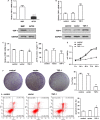TSP-1 is downregulated and inversely correlates with miR-449c expression in Cushing's disease
- PMID: 31016850
- PMCID: PMC6533510
- DOI: 10.1111/jcmm.14297
TSP-1 is downregulated and inversely correlates with miR-449c expression in Cushing's disease
Abstract
The pathogenesis of Cushing's disease, which is caused by pituitary corticotroph adenoma, remains to be studied. Secreted angioinhibitory factor thrombospondin-1 (TSP-1) is an adhesive glycoprotein that mediates cell-to-cell and cell-to-matrix interactions and is associated with platelet aggregation, angiogenesis and tumorigenesis. We have found that the expression of TSP-1 is significantly lower in human pituitary corticotroph tumours compared with normal adenohypophysis. This study aims to elucidate the role of TSP-1 in regulating the tumour function of pituitary adenomas. Forced overexpression of TSP-1 in a murine AtT20 pituitary corticotroph tumour cell line decreased corticotroph precursor hormone proopiomelanocortin (POMC) transcription and adrenocorticotropic hormone (ACTH) secretion. Functional studies showed that TSP-1 overexpression in pituitary adenoma cells suppressed proliferation, migration and invasion. We have demonstrated that TSP-1 is a direct target of miR-449c. Further study showed that miR-449c activity enhanced tumorigenesis by directly inhibiting TSP-1 expression. Low expression of lncTHBS1, along with low expression of TSP-1, was associated with the high expression of miR-449c in Cushing's disease patients. Furthermore, RNA-immunoprecipitation associates miR-449c with lncTHBS1 suggesting that lncTHBS1 might be a negative regulator of miR-449c. Taken together, this study has demonstrated that lncTHBS1 might function as competing endogenous RNA for miR-449c, which could suppress the development of Cushing's disease.
Keywords: ACTH-secreting pituitary adenomas; Cushing's disease; lncTHBS1; miR-449c; thrombospondin-1.
© 2019 The Authors. Journal of Cellular and Molecular Medicine published by John Wiley & Sons Ltd and Foundation for Cellular and Molecular Medicine.
Conflict of interest statement
The authors confirm that there are no conflicts of interest.
Figures







Similar articles
-
Expression of genes related to corticotropin production and glucocorticoid feedback in corticotroph adenomas of dogs with Cushing's disease.Domest Anim Endocrinol. 2009 Jan;36(1):3-12. doi: 10.1016/j.domaniend.2008.08.002. Epub 2008 Sep 18. Domest Anim Endocrinol. 2009. PMID: 18818046
-
Inhibitory effects of SOM230 on adrenocorticotropic hormone production and corticotroph tumor cell proliferation in vitro and in vivo.Mol Cell Endocrinol. 2014 Aug 25;394(1-2):37-46. doi: 10.1016/j.mce.2014.07.001. Epub 2014 Jul 8. Mol Cell Endocrinol. 2014. PMID: 25011056
-
Cold inducible RNA binding protein upregulation in pituitary corticotroph adenoma induces corticotroph cell proliferation via Erk signaling pathway.Oncotarget. 2016 Feb 23;7(8):9175-87. doi: 10.18632/oncotarget.7037. Oncotarget. 2016. PMID: 26824322 Free PMC article.
-
Pathophysiology and treatment of subclinical Cushing's disease and pituitary silent corticotroph adenomas [Review].Endocr J. 2014;61(10):941-8. doi: 10.1507/endocrj.ej14-0120. Epub 2014 Jun 29. Endocr J. 2014. PMID: 24974880 Review.
-
The role of somatostatin analogs in Cushing's disease.Pituitary. 2004;7(4):257-64. doi: 10.1007/s11102-005-1404-x. Pituitary. 2004. PMID: 16132202 Review.
Cited by
-
Diagnostic and prognostic utility of plasma thrombospondin-1 levels in traumatic brain injury.Eur J Trauma Emerg Surg. 2024 Oct;50(5):2229-2237. doi: 10.1007/s00068-024-02605-9. Epub 2024 Aug 7. Eur J Trauma Emerg Surg. 2024. PMID: 39112761
-
Wnt-Signaling Regulated by Glucocorticoid-Induced miRNAs.Int J Mol Sci. 2021 Oct 29;22(21):11778. doi: 10.3390/ijms222111778. Int J Mol Sci. 2021. PMID: 34769207 Free PMC article.
-
MicroRNAs as Potential Biomarkers in Pituitary Adenomas.Noncoding RNA. 2021 Sep 3;7(3):55. doi: 10.3390/ncrna7030055. Noncoding RNA. 2021. PMID: 34564317 Free PMC article. Review.
-
Novel Insights into Pituitary Tumorigenesis: Genetic and Epigenetic Mechanisms.Endocr Rev. 2020 Dec 1;41(6):821-46. doi: 10.1210/endrev/bnaa006. Endocr Rev. 2020. PMID: 32201880 Free PMC article. Review.
-
Genetic and Epigenetic Causes of Pituitary Adenomas.Front Endocrinol (Lausanne). 2021 Jan 26;11:596554. doi: 10.3389/fendo.2020.596554. eCollection 2020. Front Endocrinol (Lausanne). 2021. PMID: 33574795 Free PMC article. Review.
References
Publication types
MeSH terms
Substances
LinkOut - more resources
Full Text Sources
Miscellaneous

